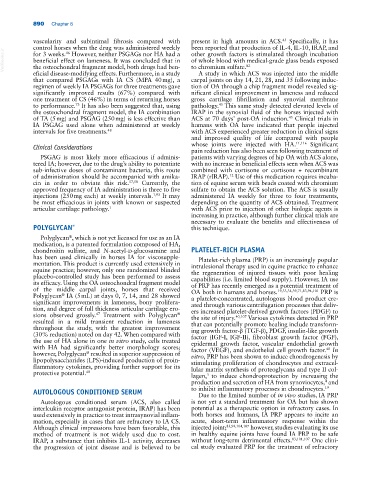Page 924 - Adams and Stashak's Lameness in Horses, 7th Edition
P. 924
890 Chapter 8
vascularity and subintimal fibrosis compared with present in high amounts in ACS. Specifically, it has
45
control horses when the drug was administered weekly been reported that production of IL‐4, IL‐10, IRAP, and
VetBooks.ir beneficial effect on lameness. It was concluded that in of whole blood with medical‐grade glass beads exposed
other growth factors is stimulated through incubation
for 3 weeks. However, neither PSGAGs nor HA had a
46
to chromium sulfate.
the osteochondral fragment model, both drugs had ben-
82
eficial disease‐modifying effects. Furthermore, in a study A study in which ACS was injected into the middle
that compared PSGAGs with IA CS (MPA 40 mg), a carpal joints on day 14, 21, 28, and 35 following induc-
regimen of weekly IA PSGAGs for three treatments gave tion of OA through a chip fragment model revealed sig-
significantly improved results (67%) compared with nificant clinical improvement in lameness and reduced
one treatment of CS (46%) in terms of returning horses gross cartilage fibrillation and synovial membrane
to performance. It has also been suggested that, using pathology. This same study detected elevated levels of
45
73
the osteochondral fragment model, the IA combination IRAP in the synovial fluid of the horses injected with
of TA (5 mg) and PSGAG (250 mg) is less effective than ACS at 70 days’ post‐OA induction. Clinical trials in
45
IA PSGAG used alone when administered at weekly humans with OA have indicated that people injected
intervals for five treatments. 48 with ACS experienced greater reduction in clinical signs
and improved quality of life compared with people
whose joints were injected with HA. 11,116 Significant
Clinical Considerations
pain reduction has also been seen following treatment of
PSGAG is most likely more efficacious if adminis- patients with varying degrees of hip OA with ACS alone,
tered IA; however, due to the drug’s ability to potentiate with no increase in beneficial effects seen when ACS was
sub‐infective doses of contaminant bacteria, this route combined with cortisone or cortisone + recombinant
of administration should be accompanied with amika- IRAP (rIRAP). Use of this medication requires incuba-
12
cin in order to obviate this risk. 57,58 Currently, the tion of equine serum with beads coated with chromium
approved frequency of IA administration is three to five sulfate to obtain the ACS solution. The ACS is usually
injections (250 mg each) at weekly intervals. 1,93 It may administered IA weekly for three to four treatments,
be most efficacious in joints with known or suspected depending on the quantity of ACS obtained. Treatment
articular cartilage pathology. 1 with ACS prior to injection of other biologic agents is
increasing in practice, although further clinical trials are
necessary to evaluate the benefits and effectiveness of
POLYGLYCAN ® this technique.
Polyglycan , which is not yet licensed for use as an IA
®
medication, is a patented formulation composed of HA,
chondroitin sulfate, and N‐acetyl‐d‐glucosamine and PLATELET‐RICH PLASMA
has been used clinically in horses IA for viscosupple- Platelet‐rich plasma (PRP) is an increasingly popular
mentation. This product is currently used extensively in intralesional therapy used in equine practice to enhance
equine practice; however, only one randomized blinded the regeneration of injured tissues with poor healing
placebo‐controlled study has been performed to assess capabilities (i.e. limited blood supply). However, IA use
its efficacy. Using the OA osteochondral fragment model of PRP has recently emerged as a potential treatment of
of the middle carpal joints, horses that received OA both in humans and horses. 19,33,34,39,71,83,94,101 PRP is
®
Polyglycan IA (5 mL) at days 0, 7, 14, and 28 showed a platelet‐concentrated, autologous blood product cre-
significant improvements in lameness, bony prolifera- ated through various centrifugation processes that deliv-
tion, and degree of full thickness articular cartilage ero- ers increased platelet‐derived growth factors (PDGF) to
sions observed grossly. Treatment with Polyglycan the site of injury. 40,107 Various cytokines detected in PRP
®
47
resulted in a mild transient reduction in lameness that can potentially promote healing include transform-
throughout the study, with the greatest improvement ing growth factor‐β (TGF‐β), PDGF, insulin‐like growth
(30% reduction) noted on day 42. When compared with factor (IGF‐I, IGF‐II), fibroblast growth factor (FGF),
the use of HA alone in one in vitro study, cells treated epidermal growth factor, vascular endothelial growth
with HA had significantly better morphology scores; factor (VEGF), and endothelial cell growth factor. In
40
however, Polyglycan resulted in superior suppression of vitro, PRP has been shown to induce chondrogenesis by
®
lipopolysaccharides (LPS)‐induced production of proin- stimulating proliferation of chondrocytes and extracel-
flammatory cytokines, providing further support for its lular matrix synthesis of proteoglycans and type II col-
protective potential. 68 lagen, to induce chondroprotection by increasing the
3
production and secretion of HA from synoviocytes, and
4
AUTOLOGOUS CONDITIONED SERUM to inhibit inflammatory processes in chondrocytes. 19
Due to the limited number of in vivo studies, IA PRP
Autologous conditioned serum (ACS, also called is not yet a standard treatment for OA but has shown
interleukin receptor antagonist protein, IRAP) has been potential as a therapeutic option in refractory cases. In
used extensively in practice to treat intrasynovial inflam- both horses and humans, IA PRP appears to incite an
mation, especially in cases that are refractory to IA CS. acute, short‐term inflammatory response within the
Although clinical impressions have been favorable, this injected joint; 83,94,104,107 however, studies evaluating its use
method of treatment is not widely used due to cost. in healthy equine joints have found IA PRP to be safe
IRAP, a substance that inhibits IL‐1 activity, decreases without long‐term detrimental effects. 83,101,107 One clini-
the progression of joint disease and is believed to be cal study evaluated PRP for the treatment of refractory

